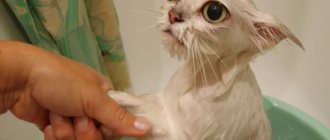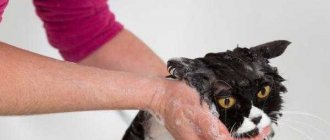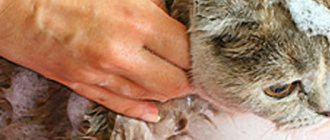Good afternoon, dear homebodies. Today we will tell you how to wash a cat if he is afraid of water and scratches - video tips will help you do it correctly and simply. By bringing a small kitten into the house, a person decides to take care of it as if it were his own child and be responsible for it.
For inexperienced furry pet caregivers, every care procedure seems complicated, but with time you can learn everything. In this article we will look at detailed instructions and useful tips on the topic of how to wash a cat.
Why do you need to wash your cat?
In fact, the tradition of washing cats only appeared after their domestication. As you know, cats that live on their own easily solve their hygiene problems on their own, with the help of their paws, tongue and amazing flexibility.
Bathing domestic cats is primarily necessary not for them, but for their owners.
A clean cat in the house means fewer problems with hair falling out, clean carpets, furniture and everything the cat touches. But domestic cats also need hygiene procedures. Here are some reasons why you should bathe cats.
- Prevention of parasites. When pets walk outside, they can bring into the house on their fur, for example, worm eggs, which can easily enter the gastrointestinal tract and cause disease. In addition, outdoors, a furry pet can become an attractive target for hungry fleas.
- During the shedding season, when cats lose hair intensively (especially long-haired breeds), digestive problems often arise due to accumulated lumps in the intestines. In this case, regular bathing will make the shedding period shorter and reduce the danger to the cat's digestive system, because you will wash away most of the fallen fur.
- Domestic cats that have lived with people for several generations often adapt to such comfortable conditions and are simply too lazy to take basic care of themselves. In this case, bathing the cat is simply necessary, because such sloths, after several visits to the toilet, begin to exude an unbearable “aroma.”
- And of course, it is worth considering the fact that some cats simply love water treatments and can happily spend time in warm, pleasant water. Why not give this kind of pleasure to your beloved cat, especially during the hot season?
To wash or not to wash
On one side of the issue is nature - free cats do not swim, and it would seem that they do not need water treatments. On the other hand, there is the issue of hygiene. Murka faces many dangers in the form of all kinds of fleas and ticks, so preventing such troubles is a necessary measure.
Veterinarians say: bathing pets is not a whim, it is a necessity. Of course, you should not abuse water procedures. Even if you manage to instill in your mustache a love of water, excessive bathing can harm your pet. But it is advisable to plan to dip the murka in water.
Some owners are ready to defend the rights of their pet. Based on natural instincts, “caring” owners prefer not to bathe their pets. Of course, water treatments for animals are not the most pleasant. However, being responsible for those they have tamed, owners must be aware of the importance of conducting such events. Even if friendship with an animal is at stake.
To bathe or not to bathe a cat? The question is philosophical. Let's consider the advantages of water procedures.
How often should you bathe your furry pet?
There are several opinions on this matter, which have their supporters and opponents. In fact, it is impossible to establish clear time periods during which a cat needs hygiene procedures.
The frequency of bathing cats depends on many factors. For example, one cat who lies on the couch all day long and licks himself down to the line can be bathed once a month, and this will be quite enough for him, but at the same time, if you take another cat who is lazy to lick himself after going to the toilet, he you will need to bathe more often.
How often a cat should be bathed is decided only by its owner. See for yourself, based on your pet’s character traits, the conditions in which he lives (how often he goes out for walks), and, of course, the needs of your furry friend. During such periods when your cat's fur is shedding, you can bathe him a little more often than usual to help him quickly renew his coat and cope with this problem.
But, it is worth understanding one important nuance - the fur of every cat, regardless of whether it is indoor or prefers a free life, is covered with a special, natural protective layer of secretion, which is produced by glands located in the skin of the animal.
If you bathe your cat too often, or use the wrong shampoo, you risk compromising this natural defense, which can cause health problems for your cat.
The first is a violation of thermoregulation processes. The cat’s immunity and stamina also suffer. Therefore, it is worth remembering that too frequent bathing may not be beneficial, but on the contrary, harm your furry friend.
Bath accessories
Before washing, do not forget to prepare everything you need so that your cat does not get scared. Remember: it will not stay in the water for long, so it is extremely important that you have everything at hand. How to bathe a cat and what should be prepared? Shampoo (it should already be on the table next to the bathroom), a soft brush for combing the coat, a special towel for drying, perhaps a small basin or bath.
Many cat owners prefer to wash their pets in small containers, believing that this way they will experience less stress. In fact, a lot depends on your mood. There is no need to buy a baby bathtub. How to bathe a cat if he stubbornly refuses to stand in the container prepared for him? Act gently, be patient and affectionate.
What is needed to bathe a cat?
In order to wash your cat, you need to prepare everything you need in advance. Let's look at the list of things needed for hygiene procedures with your pet.
- Shampoo
It is very important to choose the appropriate shampoo for bathing your cat, which will be adapted to his needs and can provide the necessary care for his fur. It is worth choosing a shampoo responsibly, taking into account the breed, coat characteristics and possible problems of the pet.
You should never use your own shampoo - this can harm your pet and cause an allergic reaction in some cases. Buy cat shampoo in specialized stores, where there is a guarantee that you will not be sold a counterfeit or low-quality product.
In addition to degreasing shampoo, a special paste is also used for long-haired cats, which is applied to those places that get dirty the most, and only then shampoo is used.
It is also worth knowing that there are several types of specialized shampoos for bathing cats. Let's look at the two most popular ones.
- Degreasing shampoo. This shampoo is used for basic cat care, regardless of its breed and characteristics. It is applied to the cat’s damp fur or after using a special degreasing paste.
- There are also texturer shampoos for cats. Shampoos of this type are used after complete degreasing of the coat in order to give it volume, shine and make combing easier (which is most important for long-haired cats).
In addition, various tinting shampoos and conditioners are also used, which are used most often for show cats, for which appearance is very important.
But, in addition to the benefits, such shampoos also have side effects, which is why they are not recommended for basic pet care and frequent hygiene procedures.
- Massage mitten.
Very often, pet owners neglect to purchase this important accessory, which makes hygiene procedures easier for cats and makes bathing more effective. In fact, a massage mitten helps to clean your pet's fur much more effectively and better.
This accessory is used for applying and carefully distributing shampoos and other care products over the cat's fur.
In addition, the massage mitten helps improve blood supply to the hair follicles, which makes the pet’s coat healthier, stronger and silkier. Therefore, if you want to make hygiene procedures for your cat not only more pleasant, but also effective, buy yourself a massage mitten.
- Clamp with silicone suction cup.
The invention appeared relatively recently, but has already begun to be in demand in pet stores and is loved by pet owners. This very simple addition will help you make hygiene procedures faster and eliminate the need to catch your obstinate pet throughout the apartment.
After all, not every cat loves water and gladly indulges in all hygienic manipulations - such pets are rather the exception. Therefore, with such a clamp it will be much easier for you.
This device is a collar for a cat, to which is attached a cord, at the end of which there is a silicone suction cup that clings to the bathtub. Thus, the restrained cat has freedom of movement, but cannot escape from the bathroom.
- Towels.
In principle, you probably guessed this yourself - after bathing the cat you will need to dry it with something. It's elementary. But it is very important that the towels you use to dry your cat are completely natural and absorb water well.
It is better to use two towels for bathing - remember that your goal is to restore thermoregulation processes as soon as possible after bathing.
Causes of hydrophobia in cats
Dogs, unlike cats, are not afraid of water and calmly tolerate the bathing process. A cat may become nervous due to a sudden change in the environment and behavior of the owner or mistress. He experiences a feeling of fear not so much of the “terrible liquid” as of immersion in it.
Fun fact! The water is clear, so the cat cannot see where its real boundaries are and begins to panic.
Whatever one may say, during the water procedure the cat must always be held tightly so that it does not scratch the owner or cause harm to itself during sudden movements. Being squeezed in a strong “hug” of a person, cats experience stress and sometimes an uncontrollable feeling of fear: “What is happening?” In addition, if there is no support (wall or shelf) for which the cat clings with its claws, it panics even more.
How to wash a cat step by step instructions
As you already understand, bathing a cat is only at first glance so simple - in fact, this activity requires patience and preliminary preparation from you. Therefore, it is better to prepare in advance in the bathroom everything that you will need during the process at different stages, so that no problems arise later.
If you have everything prepared and know what needs to be done and in what order, you will bathe your cat quickly and without unnecessary stress, both for you and for him. So, let's look at step-by-step instructions on how to wash a cat.
Step #1: Preparation
As mentioned above, it is much easier to bathe a cat if you have prepared in advance everything that is necessary for this and have prepared yourself.
If your cat is very obstinate and does not like being forced to perform hygiene procedures, which is why it tries to escape at any cost, you should think about how to make bathing safe.
It is best to give your pet a manicure before bathing - this way you will not only carry out all the grooming procedures comprehensively, but also protect yourself. In addition, it is still worth taking care to secure the cat.
If you have not purchased a special retainer, it is better to use one of your assistants who can hold the cat while you apply shampoo and perform other manipulations with the pet.
Step No. 2. Start bathing the cat
Pay attention to the temperature of the water in which you will bathe your pet - it should not be hotter than 40 degrees, but not cooler than 37. Therefore, fill the bath with a little water in advance - 10-15 centimeters. But don’t turn off the warm water - adjust it to a comfortable temperature and leave it on.
To begin with, put the cat on his paws in the bathroom - if you have secured him, you can let him go and give him 1-2 minutes so that he can adapt and understand that he is not in any danger.
But, if you haven’t restrained the cat, just hold him and stroke him - let him get used to it a little and relax. This will make bathing him easier.
After the cat stops meowing hysterically, you can gently wet his fur with warm water using a shower (you can use massage attachments).
Step No. 2. Degreasing
At this stage, a lot depends on what special hair care products you will use. If you are using a degreasing paste, apply it to all problem areas using a hard brush and leave for 1-2 minutes. Then rinse and start applying shampoo.
You can skip this stage if the cat is generally clean and its fur does not require additional degreasing. In order to distribute shampoo through your cat's fur more effectively, use the massage glove discussed above.
Shampoo should not be left on your pet’s fur for a long time - the sooner you wash it off, the safer it will be for your cat.
Nature does not provide for the effect of chemicals on cat fur, so every bath, even with the best, most expensive and gentle shampoo, is an unnatural process for the pet, and it would be better if contact with the shampoo is minimal.
Step No. 3. Rinse
After you apply the shampoo, you need to wash it off as soon as possible, and it is important to do this very carefully so that after hygiene procedures the cat does not have the slightest residue of care products on the fur.
If you use several stages of cleansing or, for example, shampoo, coloring liquid and balm, then after each of these preparations, you should thoroughly rinse your pet’s fur. Be sure to make sure that no water gets into his ears - this can end very badly.
In addition, you should make sure that after warm water the cat does not encounter a temperature contrast - the room where you bathe your pet should be warm.
Step No. 4. Drying the wool
After you have rinsed all the care products from your pet's coat, your task is to completely dry his coat. Firstly, you should immediately blot the cat with a dry natural towel and keep it wrapped in it for several minutes so that most of the moisture is absorbed.
After this, you can unwind the cat and begin to wipe off any remaining moisture with gentle movements, wiping it dry.
Many owners of long-haired cats use a hairdryer to dry their cats after bathing. But it is very important to choose the appropriate temperature regime and remember to maintain a sufficient distance so as not to harm the cat.
Step No. 5. Combing
After bathing and drying, you should give the cat a little time to recover from the stress it has experienced, warm up, and then you can begin the final stage - brushing. This is especially important if your pet is experiencing hair loss.
After bathing, it is better to wait for the fur to dry completely so as not to injure the cat during combing.
You learned how to wash cats. As you can see, bathing a cat is a fairly simple, but at the same time complex process, which also has its own nuances. But, if you use modern devices, you can make it more comfortable and simpler.
Therefore, remember that the hygiene of your pet – its health depends on it!
Also, remember that if your pet has any health problems, it is better to postpone hygiene procedures to a more favorable period.
Is it possible to trim a Persian cat's hair? Read the link on how to do it!
The correct algorithm for washing cats for all occasions
In the future, when the cat undergoes a “baptism of fire” with the first bath, follow a simple algorithm of actions:
- always prepare the bathroom, removing everything unnecessary;
- the more towels prepared, the better;
- hold the animal tightly;
- Before lowering the animal into the water, make sure its temperature is constant;
- lather the fur with a small amount of cat shampoo (this makes it faster and easier to wash off);
- It is better to foam a cap of the product and distribute it evenly over the back of the animal using a special mitten.
Helpful advice! You can prevent water from getting into your cat's ears by covering them with special tampons.
Direct the shower stream carefully, following the path of your pet's fur. The bulk of the water should fall on the back, and then be smoothly distributed throughout the animal’s body, simultaneously washing the fur. Rinse off the shampoo from top to bottom.
Newbies to bathing cats think they won't sit wrapped in a towel, but that's not true. Of course, the animal will carefully shake itself off and lick its fur, but at first it can sit quietly in a towel, because it absorbs moisture and retains heat.











